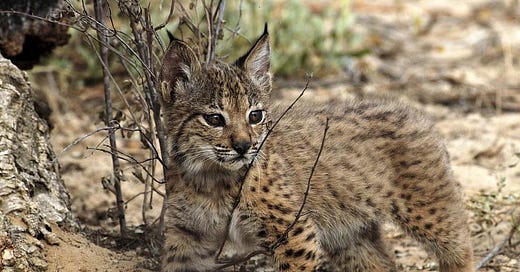Iberian Lynx Taken Off Endangered List
This week we reached an important milestone in conserving the Iberian Lynx
The Iberian Lynx was once one of the world's most endangered big cats. Native to the Iberian Peninsula, it’s long faced a severe extinction threat due to habitat loss, hunting and a decline in its primary prey - the European rabbit. Collaborative conservation efforts have now brought about a significant rebound in its population. This week it was announced that after 20 years of conservation efforts the Lynx has been officially taken off the endangered species list!
🎉 Different interventions adding up to success:
The latest census reports that the Iberian Lynx population has increased to over 1,100 individuals, a substantial rise from only 94 individuals being counted in 2002.
Extensive habitat restoration projects have been pivotal. Over 150,000 hectares of land have been rehabilitated to create corridors connecting fragmented habitats. These enable the lynx to roam free between territories, reducing the risks of inbreeding and vehicle collisions.
The contribution of captive breeding programs cannot be overstated. Several lynxes born in captivity have been successfully reintroduced into the wild, bolstering genetic diversity and population growth. These programs have been critical to maintaining a healthy lynx population and preparing new generations of lynx for life in the wild.
Legislative measures have also played a crucial role. Both Spain and Portugal have implemented strict anti-poaching laws and enhanced protections for the lynx's habitat. Incentives for landowners to participate in conservation efforts were increased to encourage vital community involvement on the ground.
🌟 Beneficial ripple effects extend beyond the Lynx:
The measures taken to protect the Iberian Lynx have also benefited other species sharing the same habitat. Efforts to restore the European rabbit population, the lynx's primary prey, have had positive effects for other predators and overall ecosystem health.
Eco-tourism has flourished as the lynx population has grown. Regions known for their lynx populations have seen a rise in tourists eager to catch a glimpse of the elusive cat, providing a boost to local economies and creating new opportunities for sustainable development.
The Iberian Lynx conservation programs have led to improved biodiversity monitoring techniques. The use of camera traps, satellite tracking, and other technologies initially deployed for lynx monitoring are now being utilised to study and protect other endangered species within the same habitats.
The success of the Iberian Lynx recovery has attracted additional funding and research opportunities. International organisations and governments are more willing to invest in conservation projects that demonstrate clear success, leading to an influx of resources for other critical conservation initiatives in the region.
🌎 So what does this mean for global conservation?
This success story for the Iberian Lynx shows us what can be achieved through comprehensive conservation which includes habitat restoration, captive breeding, re-introduction, legislative support as well as community engagement on the ground.
It also underscores the interconnectedness of species and ecosystems. Protecting a single species like the Iberian Lynx can have cascading positive effects on biodiversity, illustrating the broader impact of targeted conservation actions.
There’s an ongoing debate in the conservation world about understandable public support for certain species over others that are less exciting. The Iberian Lynx’s restoration reminds us that it’s possible to target support for animals which capture the public imagination towards keystone species who’s conservation brings wider benefits for ecosystem health.




